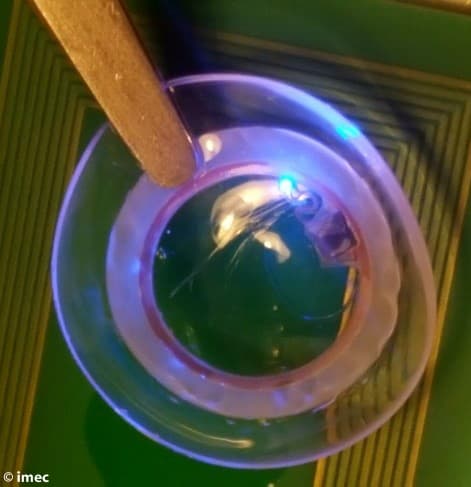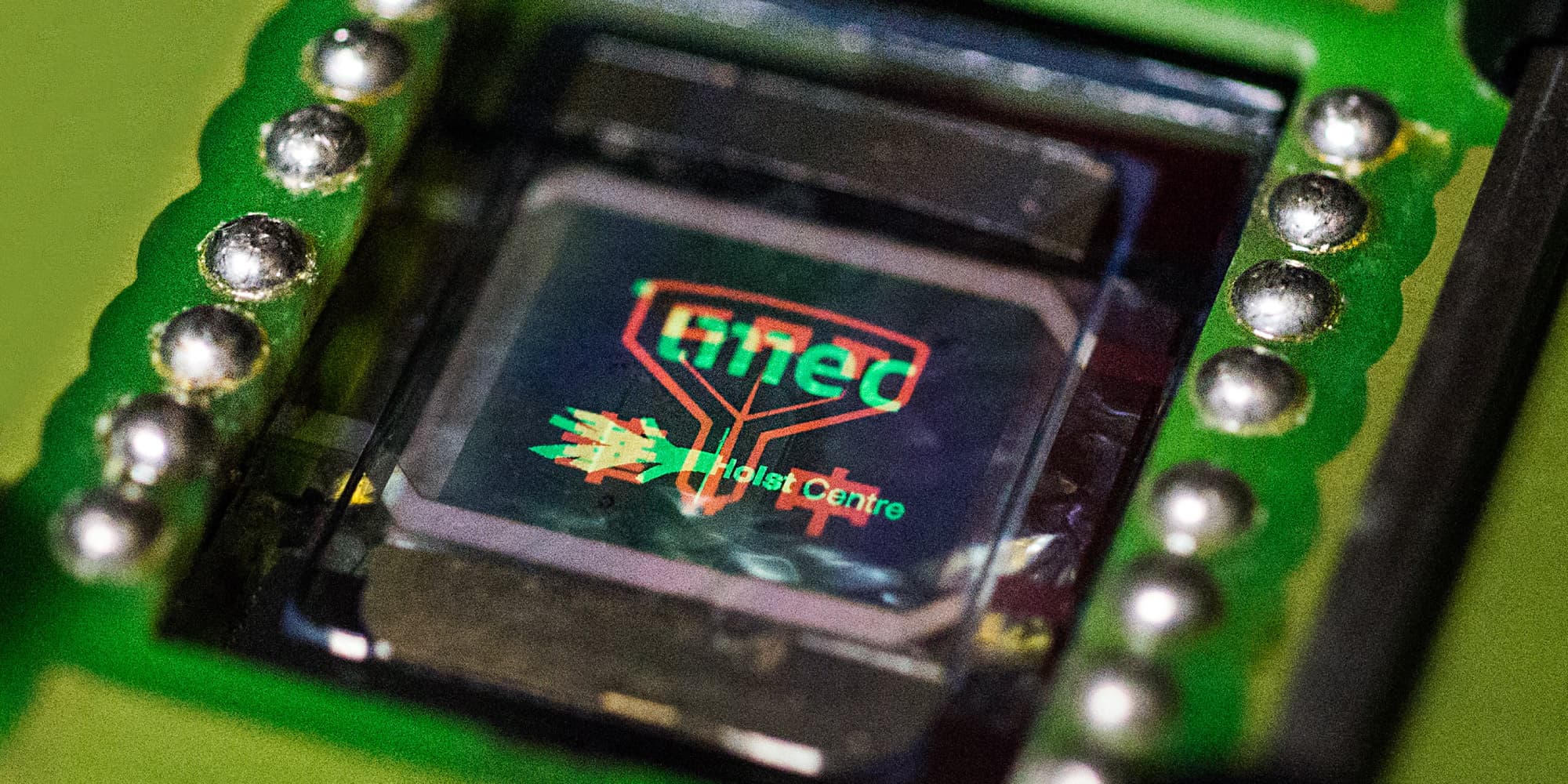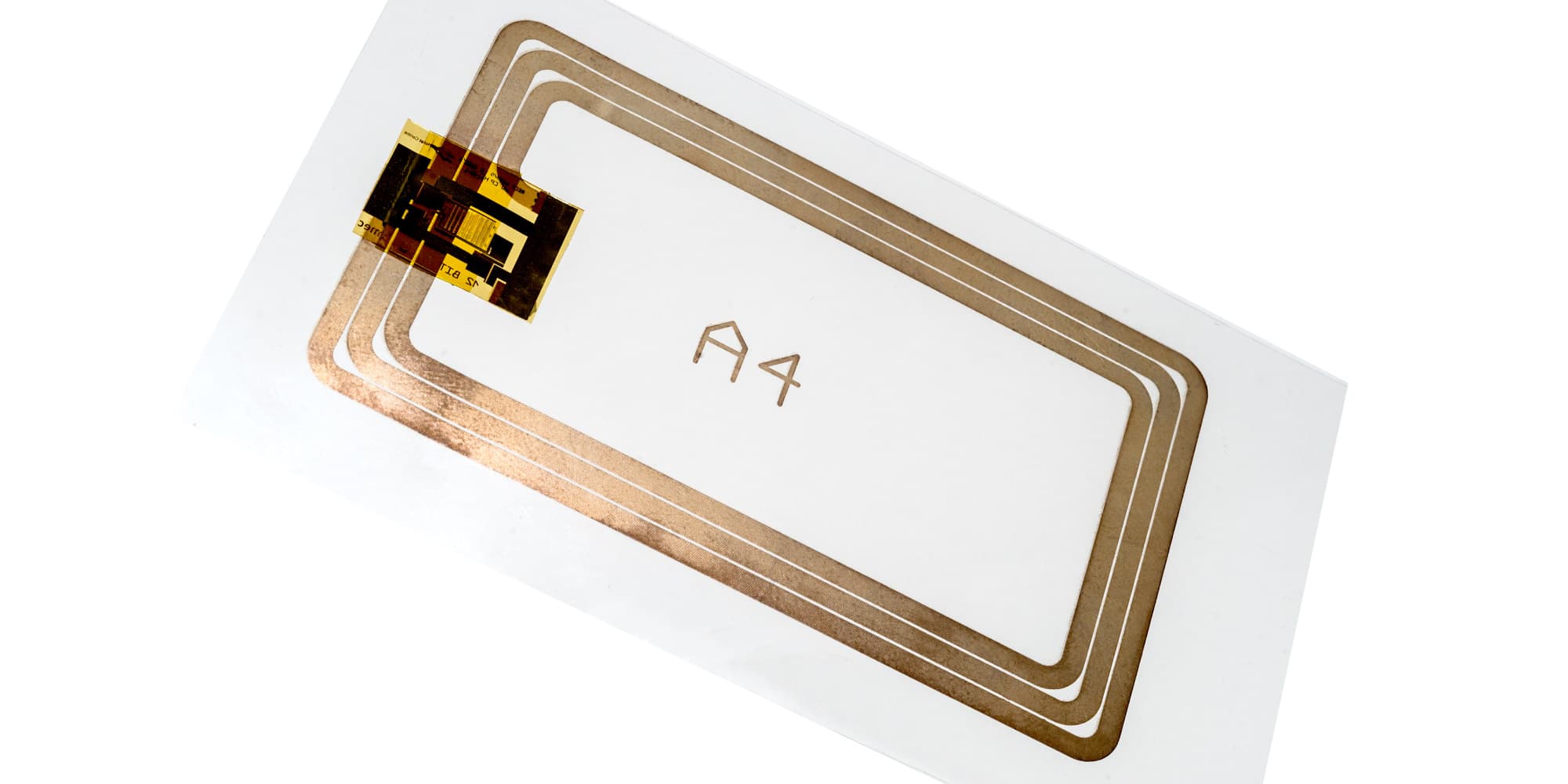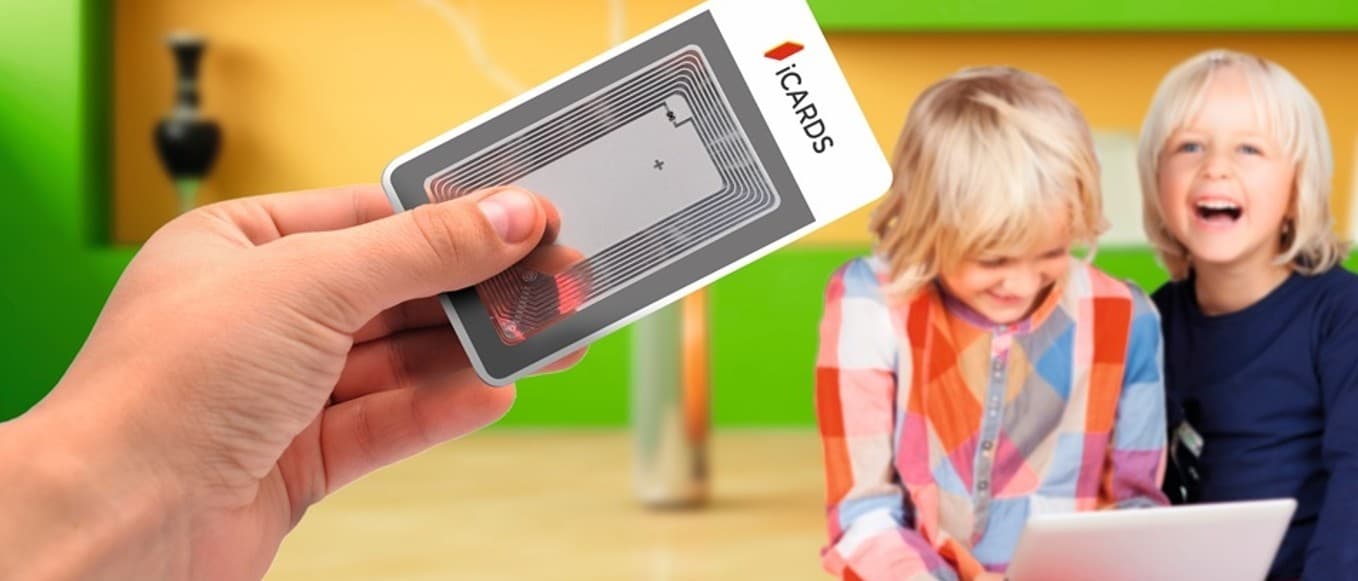Imec was recently in the news with a plastic NFC* chip that enables all sorts of objects (that have an NFC chip built in) to communicate with tablets and smartphones. Like RFID and QR, NFC is a technology that links objects with one another over a short distance. Imec and Cartamundi, the manufacturer of board games and playing cards, are developing a revolutionary new technology for short-distance communication. It involves plastic C-tokens capable of interacting with any touchscreen. Better still, they’re flexible, thin – and inexpensive. Sarah Schols (imec) and Steven Nietvelt (Cartamundi) talk about their plans.
* NFC: Near Field Communication; RFID: Radio Frequency Identification; QR: Quick Response; C-tokens: Capacitive tokens.
Why put chips in playing cards?
Steven Nietvelt is Chief Technology and Innovation Officer at Cartamundi and loves playing cards: “My favorite game is ‘Rikken’, a variant of Whist. Every Wednesday – and we’ve been doing this for over 30 years – I get together with some of my childhood friends for an evening of Rikken. We always have a really great time!”
And in doing so, Nietvelt is underlining the trend: card and board games bring people closer together. And particularly these days, in times of smartphones and the Internet, people seem to have an additional need to do so. Nietvelt: “Board games are experiencing a genuine revival. They have really come back – especially at parties or on vacation – because it is so much nicer to play a game together than for everyone to sit on their own, staring at a smartphone screen.”
So, where does the need to give board games and playing cards a digital component come from? Nietvelt: “We at Cartamundi believe that we can give games an extra dimension by involving a smartphone or some other form of display screen. This is definitely the case if we want to get the ‘smartphone addicts’ – or those youngsters who seem to have been born with a tablet in their hand – round the table together. You can either pine for the days when kids still played soccer outside (instead of playing FIFA on their PlayStation) or cowboys and Indians (instead of Grand Theft Auto)… or you can do something about it!”
“A good example is Pokemon Go, which is an app that encourages youngsters to get outside. There’s also the game Speak Out – the hit of the year – which is a great blend of the traditional game and new media. The games consists of trying to read out sentences or sayings through a mouthpiece that distorts your voice, while the person you are playing with tries to guess what you are saying. Millions of videos featuring people with mouthpieces have already been shared, usually accompanied by hilarious pictures. Which goes to show that the young (and the old) are prepared to play games with a little extra digital something, provided it stays social and fun.”
In addition to his head office in Turnhout, Cartamundi has also opened a branch in Ghent: Cartamundi Digital. This is where a.o. the Shuffle series was developed – a new generation of card games with that something extra. Nietvelt: “Often it’s a card game that can be played in conjunction with an app. If you bring the card close to your smartphone or tablet, additional information may appear, such as a video in which it looks as though your card comes to life, complete with sound, etc.”
Depending on the specific application, Cartamundi chooses from a range of technologies, including image recognition using the smartphone camera, barcodes, RFID chips embedded in the card, etc. Nietvelt: “In casinos we use cards with RFID chips so that the playing table ‘knows’ which cards are on it. This is important in major tournaments where a constant picture of the table (and the cards in the hands of the players) is displayed during live TV broadcasts.”
And Cartamundi is always looking for new ways of getting cards to communicate with smartphones or with display screens in general. Or to have playing pieces and dice communicate with the game board. Which is how they ran into imec in 2009. Initially for a feasibility study and then for two Flanders Innovation and Entrepreneurship (VLAIO) projects and also two EU projects: ORCA (Oxide RFID enabled gaming cards), WOOPI, PING and CAPID (Capacitive Identification Tokens).
Cartamundi produces card games with a little digital extra. That’s why they are always looking for technologies able to provide a link between the paper and the digital world.
Silicon or plastic?
The RFID tags (currently) used by Cartamundi in casino cards are made from silicon. But there are other ways. Sarah Schols, R&D Manager Thin Film Electronics at imec, explains: “Silicon technology is behind the success of the chip industry. But you can also make chips by printing thin layers of metal oxide on plastic. Of course these plastic chips will not replace the silicon chips in our smartphones and computers, but they are the best choice for other applications. Namely where you need very cheap, thin, flexible chips. Pallets in logistics are being tracked currently using a silicon RFID chip, but if you want to track every object on that pallet individually, you need cheaper (metal oxide) RFID labels. Or, if you want to produce an affordable deck of cards with RFID chips in each card, metal oxide technology is definitely a step forward. And with oxide tags you can also make the cards just as thin and flexible as traditional ones.
Imec has been working on the development of plastic chips for over 10 years. In 2012, the R&D center hit the world news with the first ever fully functional plastic microprocessor. Key for the researchers is to develop a technology that is compatible with industrial manufacturing. To do so, they collaborate with partners that today manufacture plastic displays (for smartphones, televisions…) and that are ready to take the next leap and start producing plastic chips for logistics and other applications. Schols: “A first challenge is to make our plastic chips more energy-efficient. Today, they typically use 10 milliwatt, but our ultimate goal is to lower that down to 10 microwatt and even lower. So we want our chips to be a 1000x more energy-efficient, a goal we’d like to reach within five years. As a second challenge, we want to make the thin-film transistors, the building blocks of our plastic chips, faster. We’ve already managed to reach the speeds needed for RFID communication, and recently even for NFC communication, which is really formidable. And as a last challenge for our plastic technology, I’d like to mention the design of circuits. To our luck, we have an enormous body of expertise in designing silicon circuits that we can leverage. Where we have 1,000 transistors per circuit today, we want to reach 100,000 in five year’s time. With that number of transistors, we’ll be ready to make plastic tags for the Internet of Things, such as sensors with integrated circuits for computations. Of course, silicon chips to that already today, but plastic chips are flexible and – most important – much cheaper!”
Thin film microprocessor on plastic film.
RFID, NFC, QR & Capacitive tokens
At the moment there are various different technologies for short distance communication. Schols clarifies: “Most of us know QR codes as the two-dimensional barcodes you see on business cards and flyers. The disadvantage is that you have to be able to scan the code accurately using the camera on your smartphone and you can’t add any extra intelligence to it. They link to a specific website and that’s it. And from an aesthetic point of view QR codes are not always possible. They can’t be integrated ‘invisibly’.”
“RFID chips exist in both silicon and oxide technology. The RFID tag can be scanned by a dedicated RFID reader that has to be brought close to the tag. NFC (near-field communication) tags – also in silicon or oxide technology –can be scanned by any recent smartphone or tablet. Once again you need to place the tag and reader close together.”
NFC and RFID are used in packaging to keep the logistics chain running smoothly. They also work for brand protection (scan an expensive piece of clothing with your smartphone and you’ll find out whether it’s a fake or not); marketing (scan a bottle of wine to see a video about the winemaker); and Cartamundi card games. Schols: “It really becomes interesting if you are going to combine the NFC or RFID circuits with sensors. One good example are disposable diapers with a moisture sensor and tag: the person looking after a group of small children can place her smartphone close to the diaper and the tag will indicate whether the diaper is wet or not.” This enables you to ‘scan’ a whole crowd of kids quickly so that you have more time to have fun playing with them.
In the future, crèches are likely to use diapers fitted with a moisture sensor and (NFC) tag: all the carer has to do is place her smartphone close to the diaper and the tag will tell the smartphone whether the diaper is wet or not.
Sarah Schols: “We are currently working – together with a.o. Cartamundi – on a new technology as part of the European CAPID project. In this case, the labels are oxide-based C-tokens or capacitive tokens. These are very small because they do not need an antenna. In fact they don’t use radio waves, but work with capacitance variation. Because they don’t have an antenna, they are potentially cheaper than RFID and NFC labels. These tokens can communicate with any touchscreen, although they have to be placed on the touchscreen – i.e. not at a short distance, as is the case with RFID and NFC. You could use the tokens in admission tickets (because then they are harder to fake and thus more secure), or for payments (apply your bank card to the computer screen to make a payment), or in playing pieces and dice combined with a playing board made of a display screen. Capacity technology is also of great interest for the Internet of Things, because you can then have every object (that has a capacitive token) communicate with the display screens in the vicinity. It’s important to notice that this new technology will exist next to NFC and RFID labels. For many applications it is more convenient to scan from a short distance instead of having the direct contact necessary for C-tokens. Depending on the distance needed to communicate, the most suitable technology will be chosen. Having all these different technologies at your disposal will allow to efficiently link the objects making the Internet of Things.
The future of playing cards and board games
So there are still plenty of new opportunities that Cartamundi and its customers (Hasbro, Mattel, Disney, Konami, Ravensburger, McDonald’s, Wizards Of The Coast, etc.) can use for their games. We also asked Nietvelt to look into his crystal ball: how will card and board games evolve? Nietvelt: “Traditional card games will continue to exist. They are still the most-played games in the world (especially in countries such as Spain, Italy and in South America and Asia, where people sit outside a lot or get together in a café). We are also doing very well with our Shuffle series of games where you can play a card-based version of Monopoly, Guess Who, etc., combined with an app. People like to be able to play a quick, compact game with simple rules. Most of us don’t have a lot of spare time and don’t want to spend hours sitting around playing a difficult board game. The combination of card games and digital techniques will be sure to play a role in the future. For example, it would be very interesting to be able to play Trivial Pursuit with questions updated online or with extra video and audio clips. Or imagine Monopoly keeping pace with the latest news, with house prices changing, for instance, because of the changing airplane routes above the city. Or maybe we’ll even be able to play Monopoly remotely, with Dad taking a Monopoly card game away with him on a business trip so that he can play a game with his kids in the evening by interacting with the computer screen or TV in his hotel room. No one really knows what the future will bring, but I believe that traditional card and board games will continue to exist, boosted by a nice little digital extra. There are countless possibilities and with new technologies such as oxide tags, a whole new world will open up for game inventors.”
Want to know more?
- Read the press release about the NFC chip that imec, Holst Centre and Cartamundi presented at the ISSCC conference
- Get an overview of Cartamundi’s technologies on this website
- The PING project is funded by the European Community as part of the Horizon 2020 research and innovation program (grant agreement nº 644331).
- The CAPID project is funded by the European Community as part of the Horizon 2020 research and innovation program (grant agreement nº 732389).
- The ORCA and WOOPI project was funded by VLAIO (Flanders Innovation and Entrepreneurship). (ORCA project number: 130993).

Sarah Schols was awarded her PhD in electrical engineering in 2009 from the Katholieke Universiteit Leuven, Belgium. Her Doctoral Research, which was funded by the Belgian Fund for Scientific Research (FWO), focused on the design of new device architectures and material concepts for organic light-emitting devices. Currently, she leads the Thin Film Electronics group in the Large Area Electronics Department at imec, focusing on organic and oxide electronics on film.

Steven Nietvelt studied Industrial Engineering at Groep T, followed the MBA course at Flanders Business School and a Masterclass in Innovation at Vlerick Business School. For more than 20 years he has worked for Cartamundi and contributed to the growth from 30 million to almost 400 million Euros of turnover. Steven took many management roles within the company at the HQ in Turnhout but also in Cartamundi USA. Today he is Chief Technology and Innovation Officer, overseeing the global technology and innovation activities of the group.
Published on:
5 March 2017













